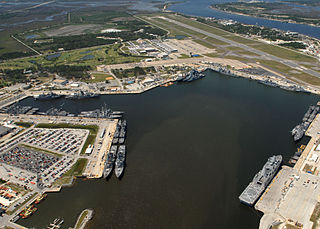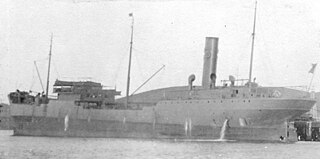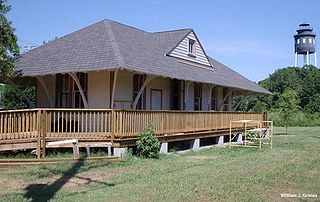Related Research Articles

Accomack County is a United States county located in the eastern edge of the Commonwealth of Virginia. Together, Accomack and Northampton counties make up the Eastern Shore of Virginia, which in turn is part of the Delmarva Peninsula, bordered by the Chesapeake Bay and the Atlantic Ocean. Accomac is the county seat.

The fifth USS Boston was a protected cruiser and one of the first steel warships of the "New Navy" of the 1880s. In some references she is combined with Atlanta as the Atlanta class, in others as the Boston class.

Naval Station Mayport is a major United States Navy base in Jacksonville, Florida. It contains a protected harbor that can accommodate aircraft carrier-size vessels, ship's intermediate maintenance activity (SIMA) and a military airfield with one asphalt paved runway (5/23) measuring 8,001 ft × 200 ft.

The second USS Abarenda (IX-131) was a storage tanker, one of many miscellaneous-class Navy vessel crewed by the United States Coast Guard during World War II.

The first USS Accentor (AMc-36) was the lead boat of the Accentor of coastal minesweepers in the service of the United States Navy, named after the accentor bird.

The Eastern Shore of Virginia is the easternmost region of the Commonwealth of Virginia in the United States. It consists of two counties on the Atlantic coast. It is detached from the mainland of Virginia by the Chesapeake Bay. The 70-mile-long (110 km) region is part of the Delmarva Peninsula. Its population was 45,695 as of 2020.
USS Sumpter was a steamship in the United States Navy during the American Civil War.

USS Satterlee (DD-190) was a Clemson-class destroyer in the United States Navy, entering service in 1919. After brief service until 1922, the ship was placed in reserve. The ship was reactivated for World War II before being transferred to the Royal Navy in 1940. Renamed HMS Belmont, the destroyer was used as a convoy escort in the Battle of the Atlantic where she was torpedoed and sunk on 31 January 1942.
United States ship naming conventions for the U.S. Navy were established by congressional action at least as early as 1862. Title 13, section 1531, of the U.S. Code, enacted in that year, reads, in part,
The vessels of the Navy shall be named by the Secretary of the Navy under direction of the President according to the following rule: Sailing-vessels of the first class shall be named after the States of the Union, those of the second class after the rivers, those of the third class after the principal cities and towns and those of the fourth class as the President may direct.
USS Bateleur (AMc-37) was an Accentor-class coastal minesweeper in the U.S. Navy. She was named after the bateleur, a short-tailed eagle common to eastern Africa.
USS Oriole (AMCU-33) was a LCI(L)-351-class large landing craft of the United States Navy, later converted to an AMCU-7-class coastal minesweeper.

USS Grouse (AMS-15/YMS-321) was a YMS-1-class minesweeper of the YMS-135 subclass built for the United States Navy during World War II.

USS Mona Island (ARG-9) was Luzon-class internal combustion engine repair ship in service with the United States Navy from 1944 to 1947. She was sunk as an artificial reef in 1975.

USS Siskin (AMS-58/YMS-425) was a YMS-1-class minesweeper of the YMS-135 subclass built for the United States Navy during World War II. She is the only U.S. Navy ship to be named for the siskin.

USRC Mohawk, was a steel steam powered revenue cutter built for the U.S. Revenue Cutter Service by William R. Trigg Company at Richmond, Virginia. Her primary duties in the Revenue Cutter Service and Coast Guard were assisting vessels in distress and enforcing navigational laws as well as a derelict destroyer. Mohawk was sunk after a collision with another vessel in October 1917.
The Wachapreague Channel is an inlet on the Eastern Shore of the state of Virginia in the United States.
Metomkin may refer to:
Burtons Bay, formerly named Floyds Bay, is a bay on the coast of Virginia in the United States.

The third USS Despatch was a United States Navy steamer in commission from 1873 to 1891.

USS Charles (ID-1298) was a troop transport that served in the United States Navy from 1918 to 1920 and was briefly in commission as USS Harvard in 1918 and 1920. She was better known in her role as passenger liner SS Harvard, one of the premier West Coast steamships operated by the Los Angeles Steamship Company.
References
- This article incorporates text from the public domain Dictionary of American Naval Fighting Ships .The entry can be found here. (See ship namesake paragraph.)
- 1 2 Niebuhr, David H. (1993). "The Metompkin Islands: A Case Study in Ownership and Management of a Dynamic Barrier System". Dissertations, Theses, and Masters Projects. Paper 1539617654 – via College of William & Mary.
- ↑ Byrnes, Mark R.; Gingerich, Kathryn J. (1987). "Cross-island profile response to Hurricane Gloria". Coastal Sediments. 2: 1486–1502.
- ↑ Theberge, N.B. (1992). "An inventory of state owned lands along the Atlantic coast of Accomack and Northampton Counties in the Commonwealth of Virginia, A public record prepared for state and local use". Department of Ocean and Coastal Law: 7–8 – via Virginia Institute of Marine Science.
- ↑ "Metomkin". history.navy.mil. Naval History and Heritage Command. 10 August 2015. Retrieved 24 March 2016.